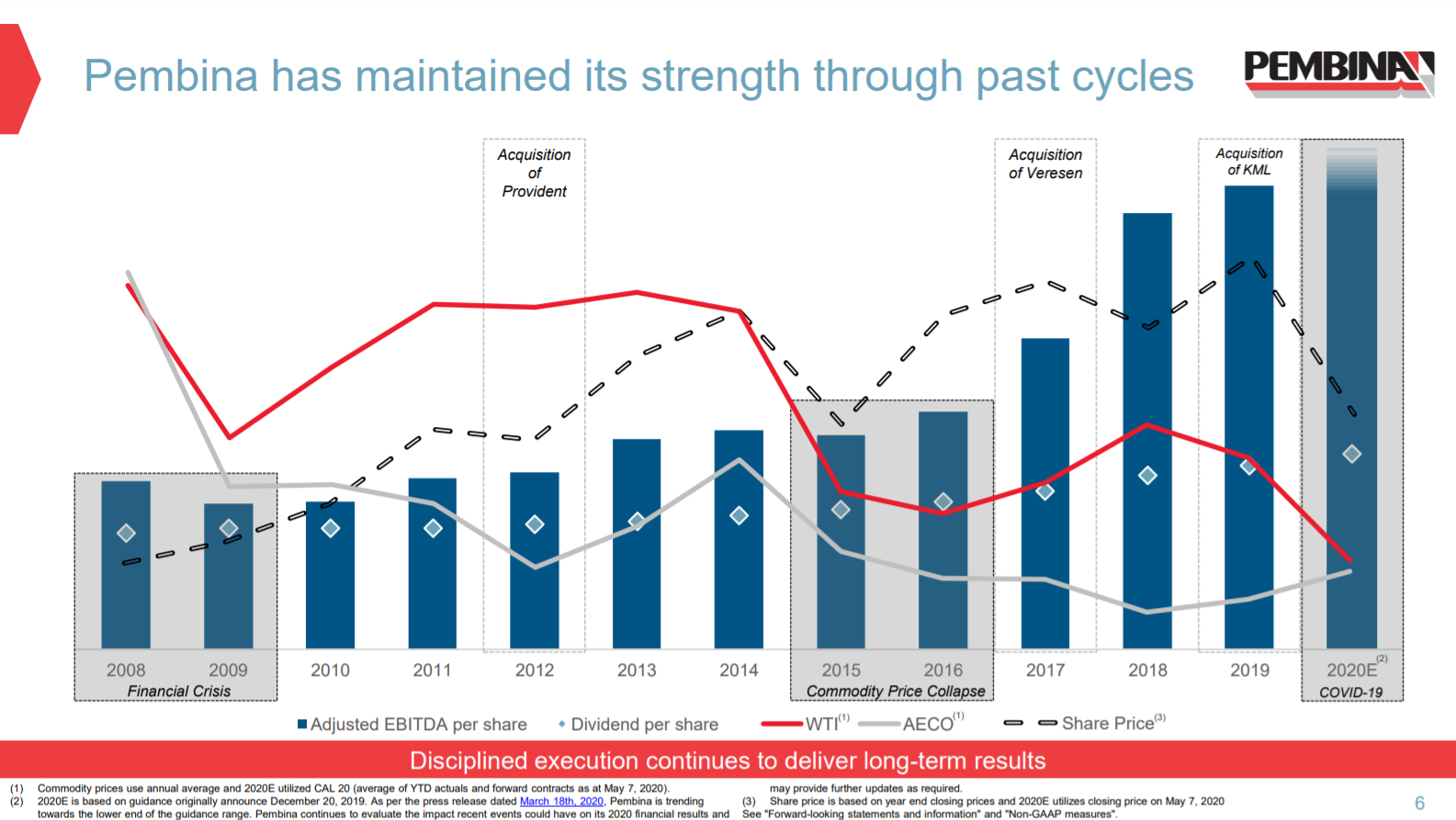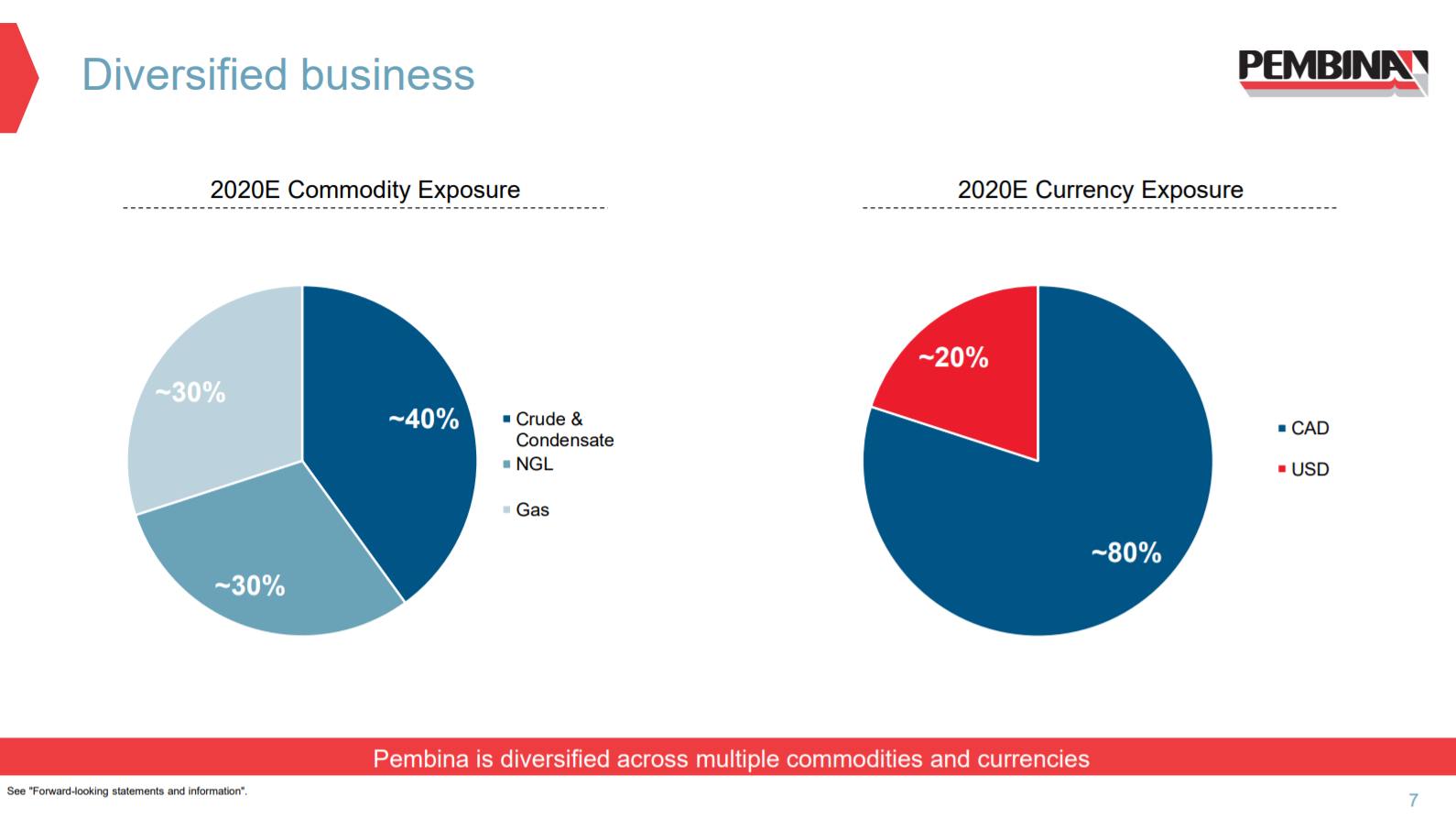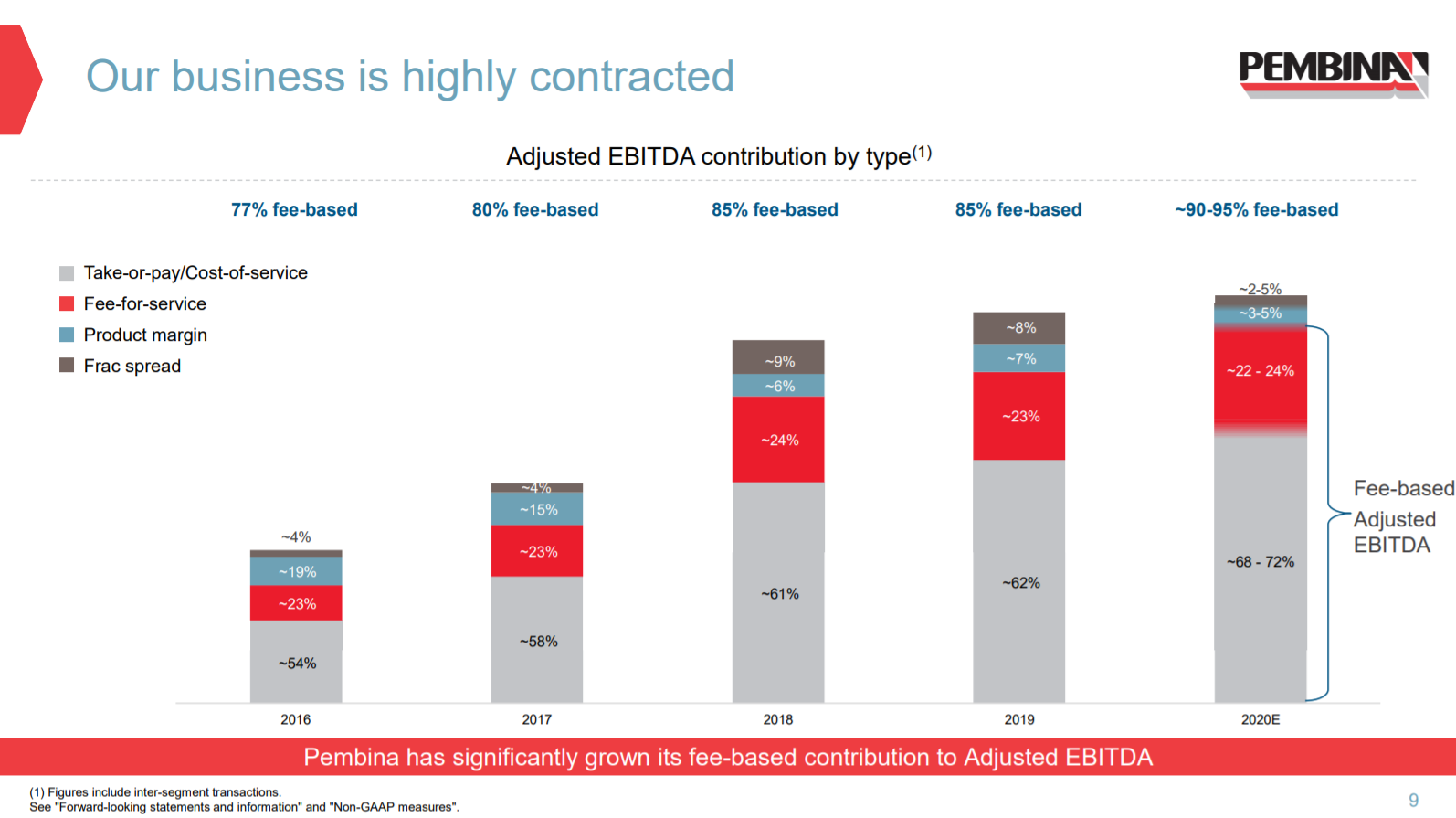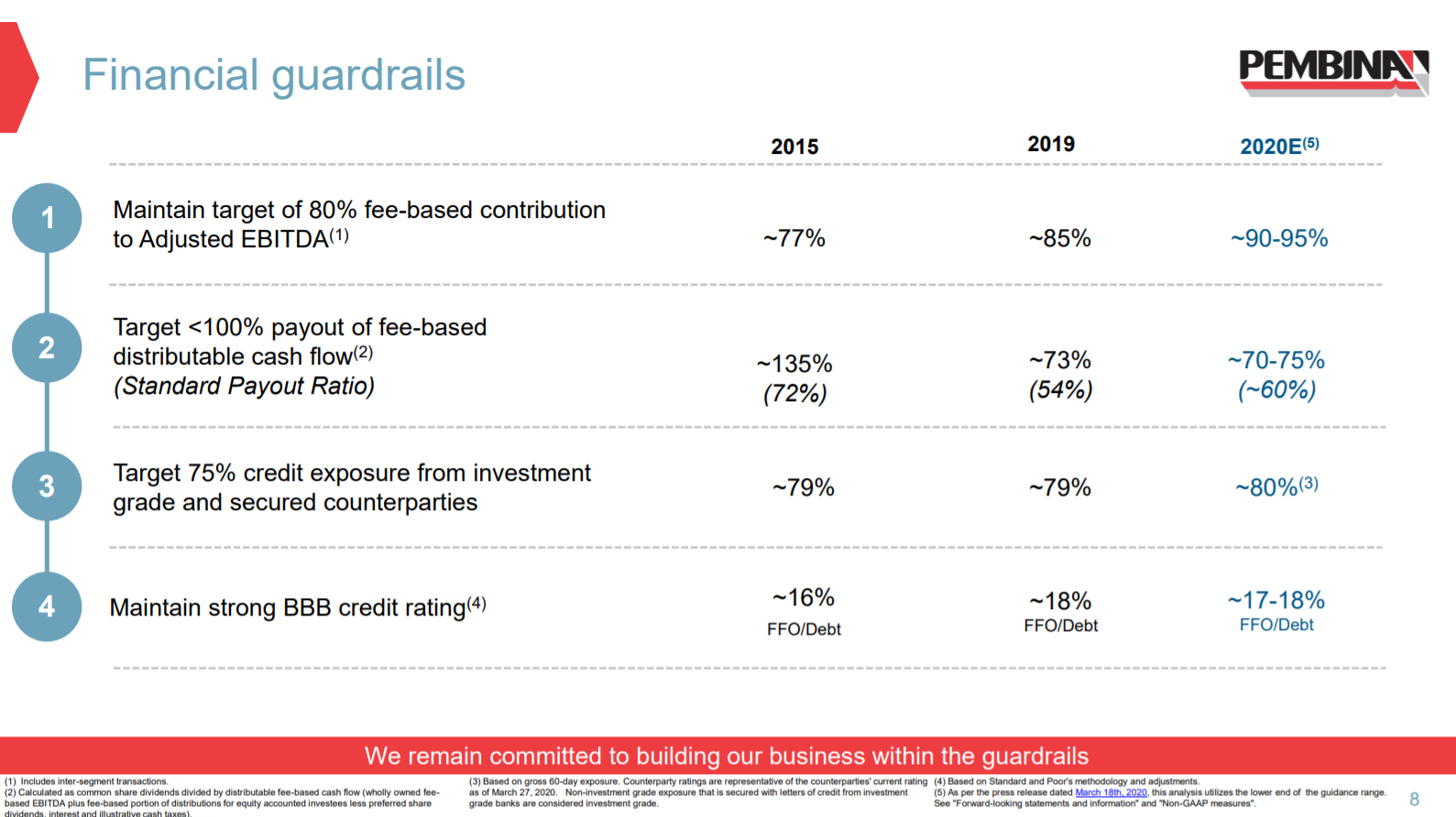Updated on June 17th, 2020 by Josh Arnold
Midstream energy companies are widely-known to be a source of high-yield dividend stocks.
Midstream operators benefit from favorable economics because of the continued need for oil around the world. In addition, midstream companies are less exposed to commodity price risk than their peers in the exploration industry.
Pembina Pipeline Corporation (PBA) is a midstream energy stock that rewards its shareholders with high dividend income.
This Canadian company – cross-listed on the Toronto Stock Exchange and the New York Stock Exchange – currently has a 6.9% dividend yield, more than three times the average yield of the S&P 500.
Pembina Pipeline is unique among midstream oil companies because it pays its dividend monthly. For retirees or other investors that rely on their dividend income to cover expenses, this is highly attractive compared to quarterly dividend payments. It also allows investors to compound wealth slightly more quickly than waiting for quarterly payouts.
Despite their appeal, monthly dividend stocks are quite rare. You can see the full list of all 56 monthly dividend stocks below:
Pembina Pipeline’s high dividend yield and monthly dividend payments make it an intriguing investment from an income perspective.
However, there is more to investing than picking a high yield, and this article will analyze the investment prospects of Pembina Pipeline in detail.
Business Overview
Pembina Pipeline Corporation is a Canadian pure-play energy infrastructure company based in Calgary, Alberta, Canada.
With a market capitalization in excess of $14 billion, and nearly $5 billion of annual revenue, Pembina has significant size and scale. Further, it has a history of delivering in a variety of economic conditions.
Source: Investor presentation, page 6
The past 12 years have seen collapses in oil prices and wide variations in economic strength, but Pembina has withstood all conditions and made sizable acquisitions in the process.
While Pembina is still beholden to crude demand, it is better insulated than companies that sell oil directly. This insulation has helped it weather many storms before, and we believe it will come out the other side of the COVID-19 crisis as well.
We also like Pembina’s diversification within the oil and gas industry, as seen below.
Source: Investor presentation, page 7
The company gets roughly even splits of revenue from crude, NGL, and gas, and derives an 80/20 split of its revenue in Canadian dollars and US dollars, respectively. This helps soften currency movements and commodity demand swings over time, and has helped Pembina perform well in a variety of conditions.
Another attractive trait about Pembina is that the vast majority of its profits come from fee-based revenue, which is much more stable and predictable than non-fee revenue.
Source: Investor presentation, page 9
Pembina’s adjusted EBITDA used to be 77% fee-based, but is slated to be 90% to 95% this year. This creates a highly stable platform from which Pembina can invest in growth and, importantly, support the dividend.
Growth Prospects
The historical growth of the Pembina Pipeline Corporation has been nothing short of amazing. Pipeline capacity is up about six-fold since 1997. Pembina has been on a years-long transformative journey to expand capacity and reduce volatility in revenue and earnings, and the results have been outstanding.
In addition, there is more capacity coming through some sizable projects in the works. The company has a strong growth runway. There are many areas of the energy infrastructure business that Pembina has not penetrated.
Source: Investor presentation, page 13
This chart shows the billions of dollars in new projects the company has for coming years, including some that are well in progress. These projects should continue to fuel growth and drive Pembina’s earnings as they have in the past.
Of course, COVID-19 has caused Pembina to defer some of this investment, but over the long-term, the company continues to possess the willingness and ability to grow its business.
Pembina is working on building out its capacity in a diversified way, expanding currently in crude, NGL, and condensate. Pembina’s recent growth has been focused on natural gas, but now that this is complete, it is focusing on its other sources of revenue.
In addition, operating margins continue to improve, something we believe will continue to occur, although not on the scale it has in the recent past. We think Pembina can grow its earnings in the mid-single digits annually in the coming years, although this growth won’t be linear.
Pembina’s current business is well-run and highly-profitable but it is also investing for the future. In all, we see Pembina’s growth outlook as strong despite the current situation with COVID-19.
Dividend Analysis
Pembina declared its most recent dividend of $0.1554 per share monthly when the payout is converted from Canadian dollars to US dollars. The current monthly dividend results in an annualized payout of $1.86 per share, for a 6.9% yield.
Note: As a Canadian stock, a 15% dividend tax will be imposed on US investors investing in the company outside of a retirement account. See our guide on Canadian taxes for US investors here.
Its coverage has been strong in the past, but a projected dip in earnings this year has the dividend in excess of earnings-per-share.
Source: Investor presentation, page 8
Pembina targets less than 100% payout of fee-based distributable cash flow, and for this year, it expects that number to be just 70% to 75%. That means the dividend – while not covered by EPS – is still very well covered by distributable cash flow.
Further, the company sees 90% to 95% of its EBITDA from fee-based revenue, meaning that the distributable cash flow it uses to pay the dividend should be highly predictable. These are very favorable characteristics when examining the safety of the dividend, particularly in conjunction with the high yield.
To its credit, Pembina has been able to grow in recent years without diluting shareholders, which would have made paying the dividend over a larger number of shares more costly. It also allows Pembina to use its commodity-exposed earnings for debt repayment, growing the dividend, and buying back stock.
We see a long runway for dividend growth ahead as well given that the company should continue to grow its earnings and distributable cash flow, and because the payout ratio on DCF is only about three-quarters. Pembina used to pay out essentially all of its free cash flow, but in recent years, growth in cash flow has greatly outpaced growth in the dividend, which has improved safety.
This has not only made the payout much safer, but has increased the runway the payout has to move higher over time. Pembina’s dividend is therefore highly-rated in terms of not only safety, but growth potential among pipeline operators.
This is a hugely attractive proposition for dividend investors and when one considers the payout is also monthly instead of quarterly, Pembina is in a class of its own.
Final Thoughts
Pembina Pipeline Corporation’s high dividend yield and monthly dividend payments are among the biggest reasons why investors might take an initial interest in the company’s publicly-traded securities.
Looking more closely, Pembina appears to be well-positioned to grow over the mid-to-long term given its robust pipeline of projects on the horizon, even with deferred capex because of COVID-19.
Pembina’s current dividend yield and growth guidance together give a high probability of strong total returns for today’s shareholders. We see the safe and growing dividend as the principal reason to own Pembina today, and believe it is an attractive stock for income investors.










